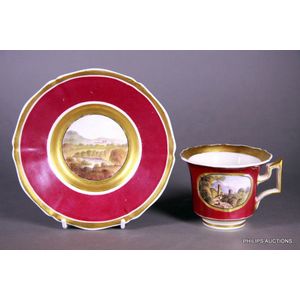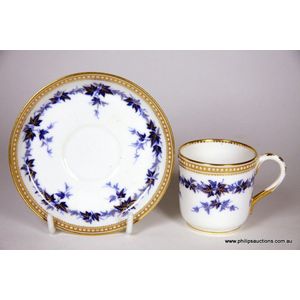Empire-style Cup and Saucer with Parisian Porcelain Decoration
You must be a subscriber, and be logged in to view price and dealer details.
Subscribe Now to view actual auction price for this item
When you subscribe, you have the option of setting the currency in which to display prices to $Au, $US, $NZ or Stg.
- Manner of .... / Style of ..... - A cataloguing term where the item, in the opinion of the cataloguer is a work in the style of the artist, craftsman or designer, possibly of a later period.
- Gilding - Gilding is a method of ornamentation whereby a thin sheet of gold metal is applied to items made of wood, leather, ceramics, glass and silver for decorative purposes.
For furniture including mirrors, the sheet of gold is usually applied over a coating of gesso. Gesso is a mixture of plaster of Paris and gypsum mixed with water and then applied to the carved wooden frames of mirrors and picture frames as a base for applying the gold leaf. After numerous coats of gesso have been applied, allowed to dry and then sanded a coat of "bole", a usually red coloured mixture of clay and glue is brushed on and allowed to dry, after which the gold leaf is applied. Over time parts of the gilding will rub off so the base colour can be seen. In water gilding, this was generally a blue colour, while in oil gilding, the under layer was often yellow. In Victorian times, gilders frequently used red as a pigment beneath the gold leaf.
Metal was often gilded by a process known as fire gilding. Gold mixed with mercury was applied and heated, causing the mercury to evaporate, the long-term effect of which was to kill or disable the craftsman or woman from mercury poisoning. The pursuit of beauty has claimed many victims, not the least of which were the artists who made those pieces so highly sought after today.
This item has been included into following indexes:
Visually similar items

A Rockingham Named View cup and saucer, circa 1830, pattern 558, the maroon ground duo with lobed gilded edges and borders, the saucer depicting 'Murthly Castle, Near Dunkeld' and the square handled cup with an additional view of ruins; printed griffin mar

Berlin porcelain cup and saucer, blue and gilt restored and worn, 19th century (KPM mark to base)

A Flight Barr & Barr Worcester 'Rock and Fence' Imari trio, 1813-40 period, richly decorated in the Imari palette with underglaze blue and enamel colours and touches of pink and apple green, with abundant foliage, ornamental garden architecture and birds,

A Royal Worcester demitasse cup and saucer, 1878, pattern B 379, with trailing borders of dark and light blue ivy and gilded highlights with jewelled borders upon a white ground; with puce backstamp, pattern number and decorator's mark underside. Height 5.
